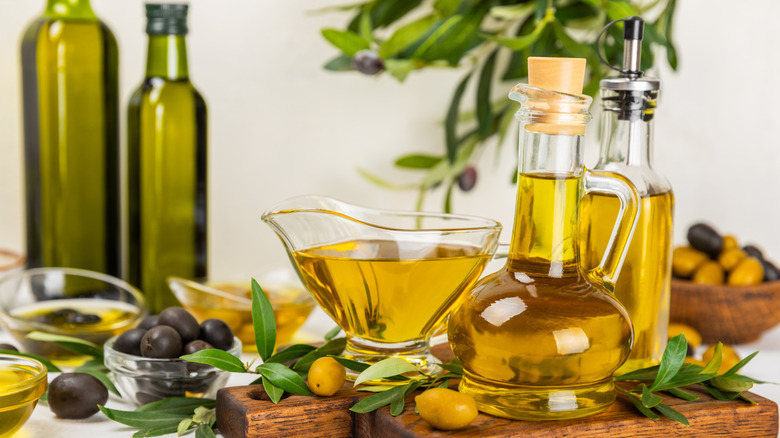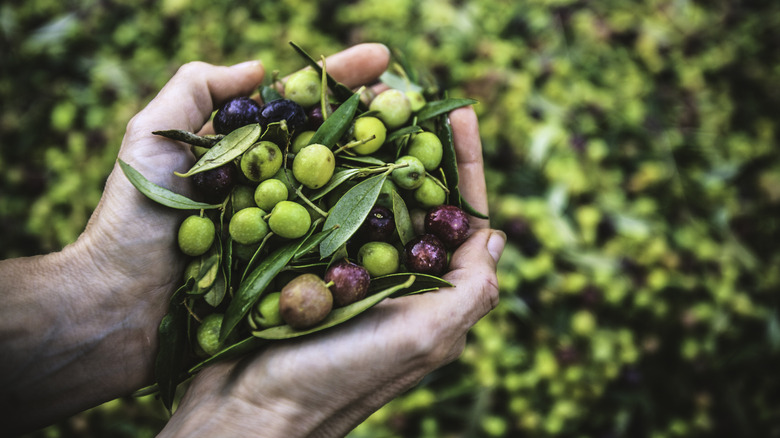How Is Blended Olive Oil Different From Single Origin?
We may receive a commission on purchases made from links.
Although olive oil is now mass-produced and sold in almost every grocery store worldwide, this sacred oil, often referred to as "liquid gold," has a long and intricate history dating back to early Greece almost 8,000 years ago. In the Mediterranean basin, people believed that the olive trees were sent as gifts from the goddess Athena, and given how the ancient ingredient remains revered and beloved to this day, they may not be entirely wrong.
These days, olive oils from around the world fill supermarket shelves, with Spain, Italy, Turkey, Tunisia, and Greece as the top five highest producers. But when you pick up a bottle, ready to saute some vegetables or begin a red sauce for your linguine, do you understand the differences on the label? Beyond the "extra virgin" or "refined" classification, another important category for consideration is blended olive oil versus single-origin olive oil, and the distinction can make a significant flavor difference in your recipes. Each type has a distinctive flavor, character, price point, and use in the kitchen. It all comes down to the olives themselves: Single-origin olive oil comes from one particular type of olive from one region of the world, and blended olive oil can be made from a variety of olives.
Single-origin olive oil: what's the big deal?
When you think of single-origin olive oil, imagine that orchard in Spain, Italy, or Greece — rows and rows of beautiful olive trees, bright green and deep purple fruits heavy on the branches. Now, imagine you spend the day plucking those fruits. You use the bounty of the day, selecting only those particular fruits collected from those particular trees in that particular orchard, to purify and create your bottle of oil. That's what it means to be single-origin. The bottle of oil comes from a specific region, a single source, and is never mixed with other oils. It remains pure to the source, bringing a unique flavor profile. Their flavor tends to be stronger and more recognizable than the blended variety, making them useful for applications where you want the flavor to shine, as in salads or other fresh simple dishes.
That distinctiveness is what makes single-origin olive oil so popular. Since the bottle is produced from fruits grown in a specific region, it brings a flavor profile that is a reflection of the tree's distinct climate and soil. Single-origin oil allows a chef to play on the unique flavors of a particular region, making it extremely useful to enhance the body and texture of certain recipes. Single-origin olive oil is also a preferred choice because it is the healthiest version of olive oil.
Blended olive oil offers a more affordable price point
While single-origin olive oils are usually in the spotlight, blended olive oil has its uses, too. Where single-origin olive oil means a bottle of oil with fruits from a singular source, blended olive oil is a combination of fruits from separate locations. Manufacturers also tend to use older oil for blended olive oil, which means that the flavor is less intense.
Some chefs argue that blended olive oils have less taste. Since you're combining so many sources into a single bottle, you're disturbing the flavor profile. But other chefs use this blend to their advantage, noting that the layers of flavors create a journey for the palate. Blended olive oils also come at a much cheaper price point. Think $5-10 for a bottle of Pompeian Extra Virgin Olive Oil versus $40 for a bottle of Frantoio Pruneti Olive Oil.
Whether you prefer the nuanced flavors of single-origin olive oil or the combination of profiles in a bottle of blended olive oil, both have a place in the kitchen. The choice depends on both your budget and culinary goals. Embracing the diversity of olive oils can not only enhance your cooking experience but also introduce you to a whole new world of kitchen snobbery.


